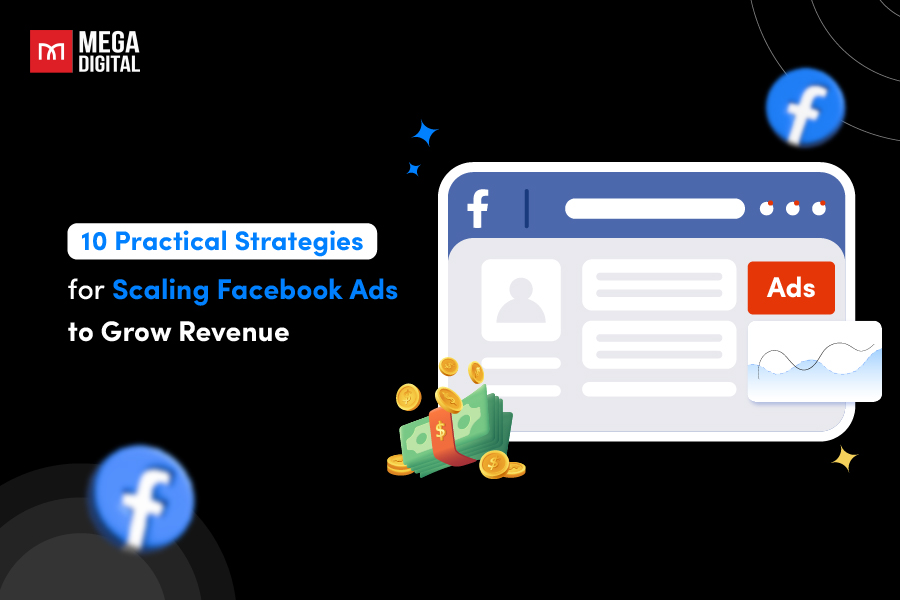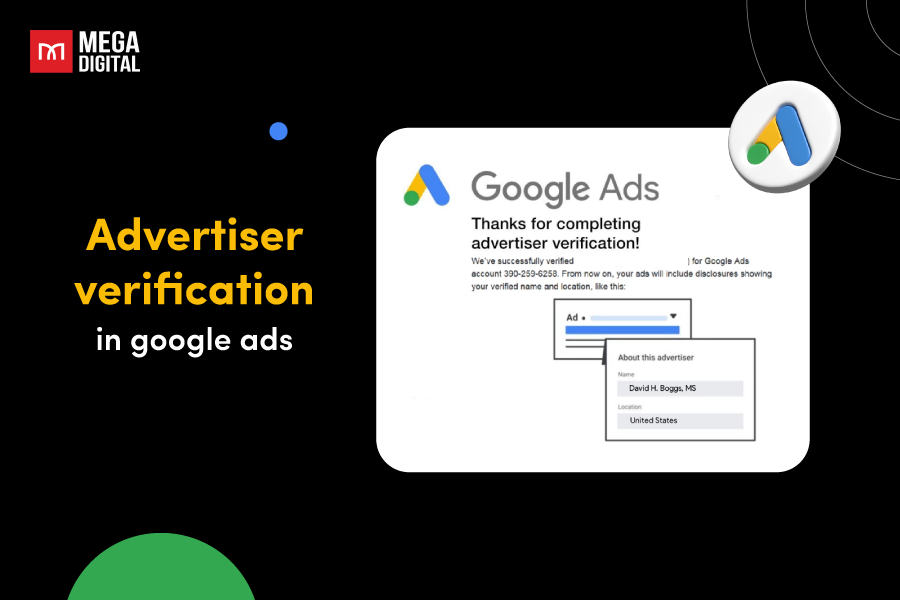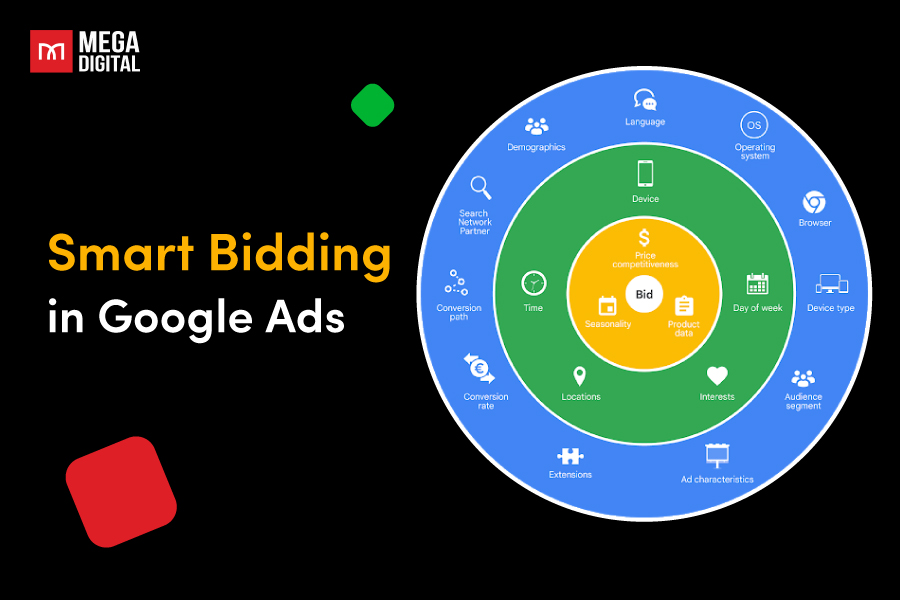Native to search arbitrage is a powerful strategy for online search arbitrageurs looking to maximize their ROAS. In this article, I will walk you through the mechanics of native to search arbitrage and provide practical insights with strategies for launching a successful campaign.
QUICK SUMMARY
- Native to search arbitrage = buy low-cost native ads, drive clicks to search-feed pages or your site, monetize higher-paying ads, keep the margin.
- It’s compelling because native ads blend in (less fatigue/blocks), often beat display CTR, and stay steadier through algorithm shifts.
- Winning hinges on sharp targeting, high-quality creatives and pre-landers, mobile speed, bot filtering, and continuous A/B testing.
- This guide shows working flows, best native formats and networks (Taboola, Outbrain, Pangle, MGID), prep checklists, a real case study, and optimization tips to scale profit.
- What is Native to Search Arbitrage?
- How does Native Ad Arbitrage Work?
- Benefits of Native Ads for a Search Arbitrage Campaign
- Types of Native Ads in Ad Arbitrage
- What to Prepare Before Creating a Native Ad Arbitrage Campaign?
- Best Native Networks for Search Arbitrage
- How to Choose the Perfect Native Ad Network for Your Campaign?
- How to Create a Native Ads Campaign for Arbitrage?
- Tips to Have a Well-Performing Native Ads Campaign
- An Example of a Native Ad Arbitrage Campaign & Lessons Learned
What is Native to Search Arbitrage?
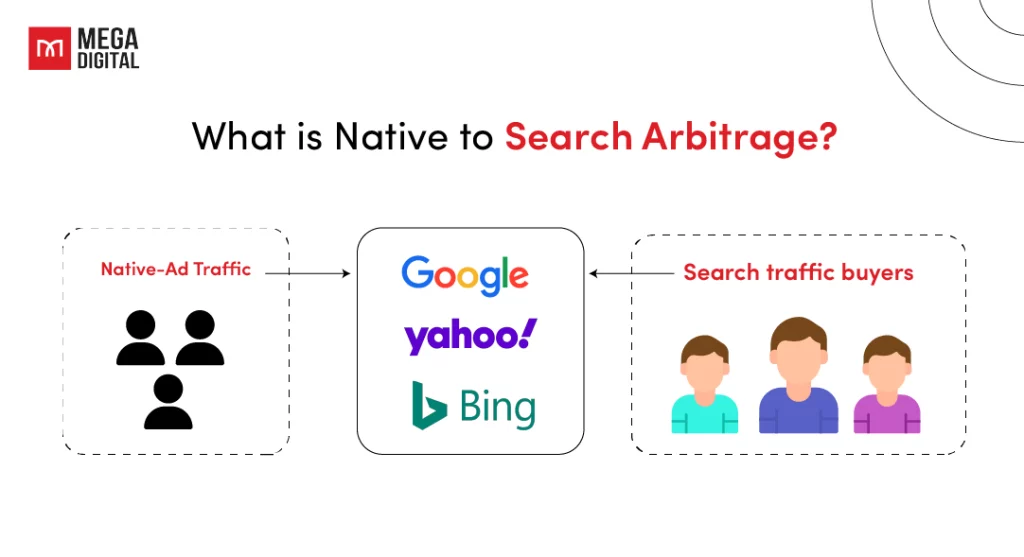
Native to search arbitrage is a digital marketing strategy where marketers purchase low-cost native advertisements to drive traffic to search feed pages (powered by search feed providers) or their websites. These pages then display higher-paying ads. The goal is to profit from the difference between the cost of acquiring traffic and the revenue generated from the ads.
How does Native Ad Arbitrage Work?
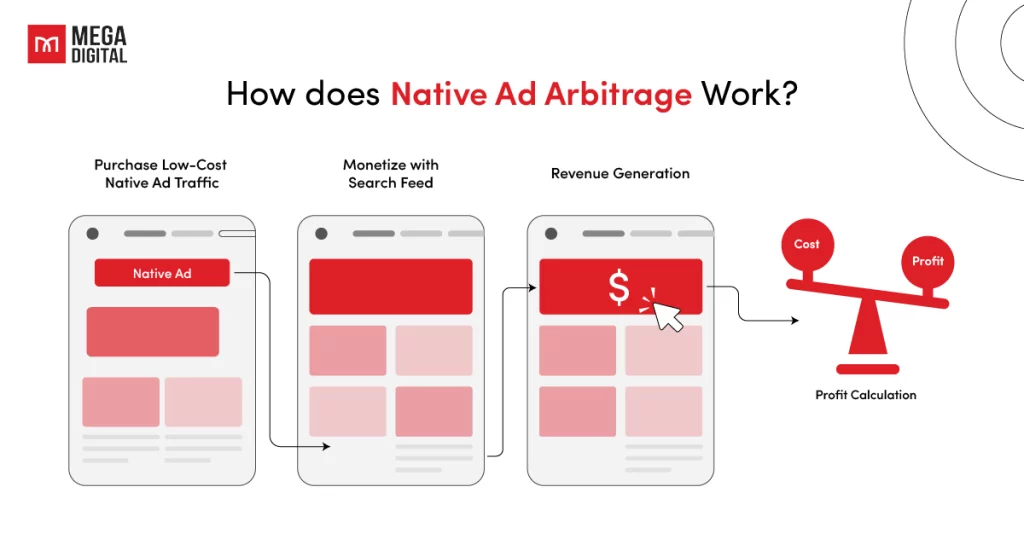
Native ad arbitrage involves buying traffic cheaply from one source and redirecting it to another, generating higher revenue through native advertising. Here’s a brief overview of how it works:
- Purchase Low-Cost Native Ad Traffic: Marketers buy traffic at a lower cost from native ads.
- Monetize with Search Feed: The traffic is then directed to a website filled with native ads, which blend in with the site’s content and encourage user engagement.
- Revenue Generation: The goal is to earn more from the native ads’ clicks or impressions than what was spent on buying the traffic.
- Profit Margin: The difference between the cost of traffic acquisition and the revenue generated from native ads represents the profit margin.
By optimizing ad placements, targeting, and content relevance, marketers aim to maximize their profits through this arbitrage process.
Benefits of Native Ads for a Search Arbitrage Campaign
Native ads boast several advantages when used in search arbitrage campaigns.
Offer better user experience and reduced ad fatigue
Native ads blend so well with the content that your website visitors won’t find them bothersome or even recognizable. Plus, they are usually designed to meet your visitors’ interests. While PPC ads, social media ads, or display ads may cause ad fatigue, the risks are significantly lower for native ads because they blend in so well with the surrounding content.
Less prone to Google’s algorithm changes
Remember that dreaded feeling of your traffic numbers dropping overnight, all due to an unexpected algorithm update? You don’t have to worry about such Google ads issues with native ads. They ensure a consistent flow of visitors, making them a reliable source of traffic for your arbitrage campaign.
Result in better CTR compared to Display Ads
Studies have shown that native ads often achieve better CTRs compared to traditional display ads. According to Outbrain, the average CTR of native ads is 0.2%, much higher than that of display ads (0.05%).
Less prone to ad blockers
Native ads are designed to seamlessly integrate with the surrounding content on a webpage or platform. This characteristic makes them less likely to be detected and blocked by ad blockers, which are typically programmed to filter out more conspicuous ad formats like banners or pop-ups, enhancing the success of your native ad arbitrage campaign.
Come with sophisticated targeting options
Many advertising networks like Outbrain and Yahoo Native / Yahoo DSP and social media platforms like Facebook, TikTok, and LinkedIn allow advertisers to reach specific audiences based on demographics, behavior, and interests.
Native to search arbitrage thrives on volume
The more traffic you can attract, the greater your potential earnings. This is where native ads shine, offering a broader reach compared to traditional advertising methods.
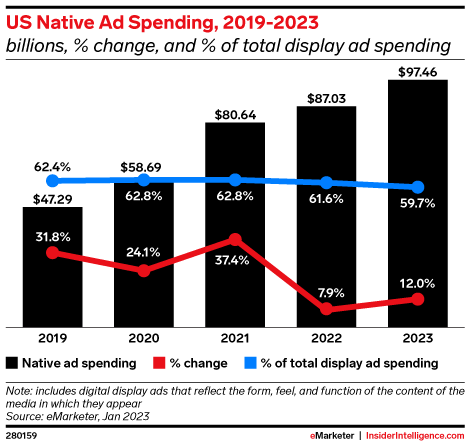
In fact, native ads have become predominant in digital advertising. According to eMarketer, spending on native digital display ads soared to $97.46 billion in 2023, representing over 59.7% of all digital display ad spending in the US. This significant investment underscores the effectiveness and growing preference for native ads among marketers.
Types of Native Ads in Ad Arbitrage
When it comes to native ad arbitrage, understanding the different types of native ads can help you choose the best format for your campaigns. Here are some of the most effective types of native ads you can use:
Recommendation Widgets

Recommendation widgets are those familiar “You might also like” or “Recommended for you” sections. These ads seamlessly blend with the surrounding content, offering users additional articles or products that match their interests.
- Pros: Recommendation widgets can increase the visibility of advertisements and promoted content, leading to higher click-through rates and potentially greater revenue from ads.
- Cons: If the recommendation algorithms are not well-optimized, the widgets may suggest irrelevant or redundant content, which can frustrate users and reduce the effectiveness of your arbitrage campaign.
Key Takeaway: Recommendation widgets are particularly effective in native ad arbitrage because they feel like a natural part of the browsing experience, which increases their ability to drive traffic to your site.
Native Video Ads
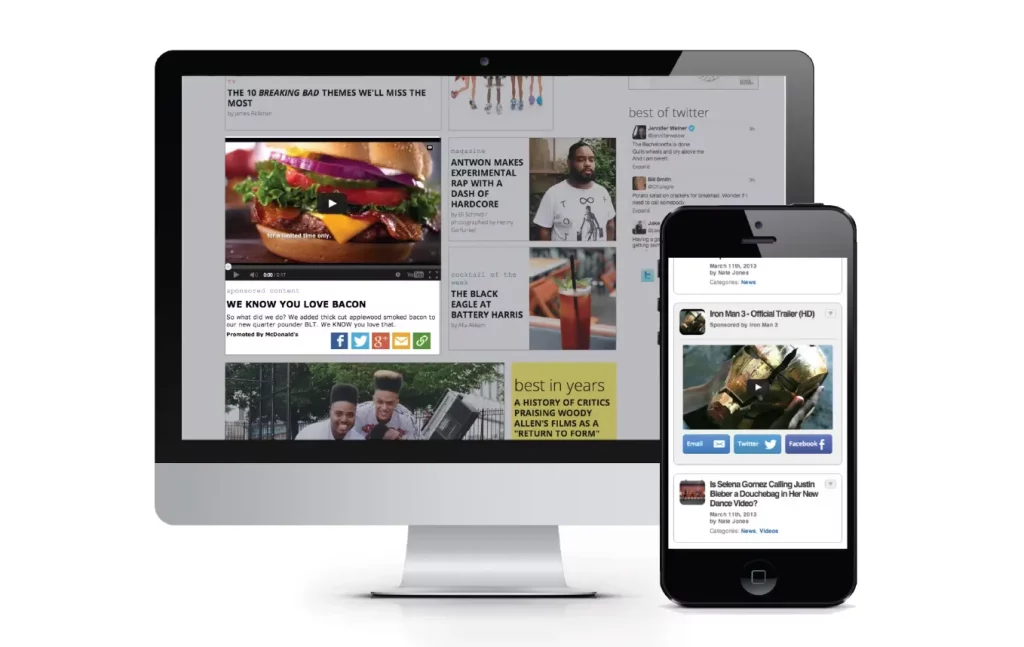
Native video ads are short videos that appear within the content feed or as standalone content on a platform. These videos are designed to look and feel like regular content, making them more engaging and less intrusive.
- Pros: Branded video ads are excellent for storytelling and can effectively “manipulate” users to interact with them. They blend seamlessly with the content, enhancing user experience and increasing engagement.
- Cons: Producing high-quality video content can be resource-intensive and costly. Additionally, if the video is not relevant or engaging, it may not capture the audience’s attention, reducing the effectiveness of the ad.
Key Takeaway: Native video ads are highly effective in native ad arbitrage campaigns due to their engaging nature and ability to tell a compelling story. However, the investment in production must be justified by the potential return through increased user engagement and traffic.
In-feed Ads
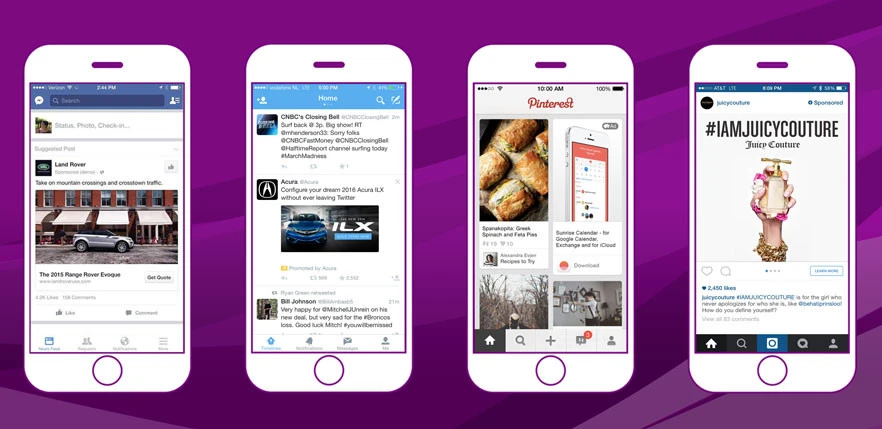
In-feed ads appear directly within the feed of a website or app. These ads are designed to match the format and style of the surrounding articles or posts.
- Pros: These ads are less disruptive and more appealing to users, maintaining engagement and driving clicks. They integrate seamlessly with the user’s browsing experience, increasing the likelihood of interaction.
- Cons: Poorly designed in-feed ads can be mistaken for clickbait or irrelevant content, leading to user frustration. Plus, if not properly targeted, they may not reach the intended audience effectively.
Key Takeaway: In-feed ads are ideal for native ad arbitrage due to their ability to blend with organic content and maintain user engagement, thus driving substantial traffic to your site.
In-content Ads
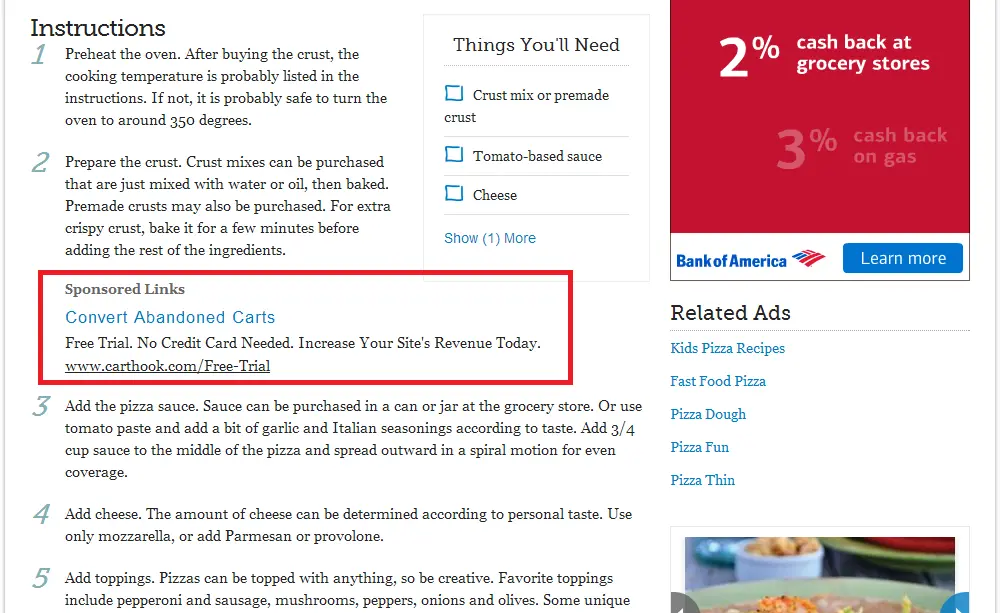
In-content ads are placed within the main body of an article, often appearing as contextual links or banners that are related to the content the user is reading.
- Pros: High engagement due to relevance; integrates smoothly with the user’s reading experience.
- Cons: If not well-targeted, in-content ads may disrupt the reading flow and reduce user satisfaction.
Key Takeaway: Effective for maximizing content engagement, driving clicks and conversions through relevant ad placements.
Promoted Listings
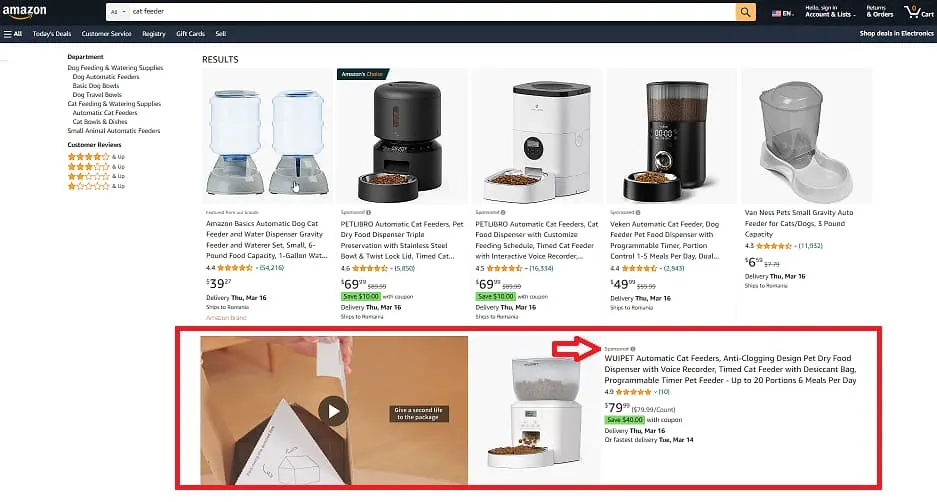
Promoted listings are commonly placed on e-commerce platforms. These ads appear alongside regular product listings but are marked as “sponsored” or “promoted.”
- Pros: They blend in with the product catalog, giving them a native feel while increasing the visibility and sales of promoted items.
- Cons: Promoted listings can sometimes be perceived as less trustworthy if not clearly marked as sponsored content. Additionally, they may require higher bids to stand out among organic listings, increasing costs.
Key Takeaway: Promoted listings are effective for native ad arbitrage on e-commerce platforms, helping to boost the visibility and sales of specific products while maintaining a native appearance.
Sponsored Content

Sponsored content, also known as advertorials, is a type of native ad where the advertiser pays for content that is published on a publisher’s site. This content often takes the form of articles, blog posts, or editorials.
- Pros: Sponsored content is effective for enhancing ad credibility. It subtly targets the users’ interests, enhancing engagement and trust.
- Cons: Creating high-quality sponsored content can be resource-intensive. Additionally, if the content is perceived as too promotional, it can deter readers and harm the credibility of the publisher.
Key Takeaway: Sponsored content is valuable in native ad arbitrage for building brand awareness and engaging readers, but it requires a careful balance between promotion and providing value to avoid deterring the audience.
In-app Native Ads
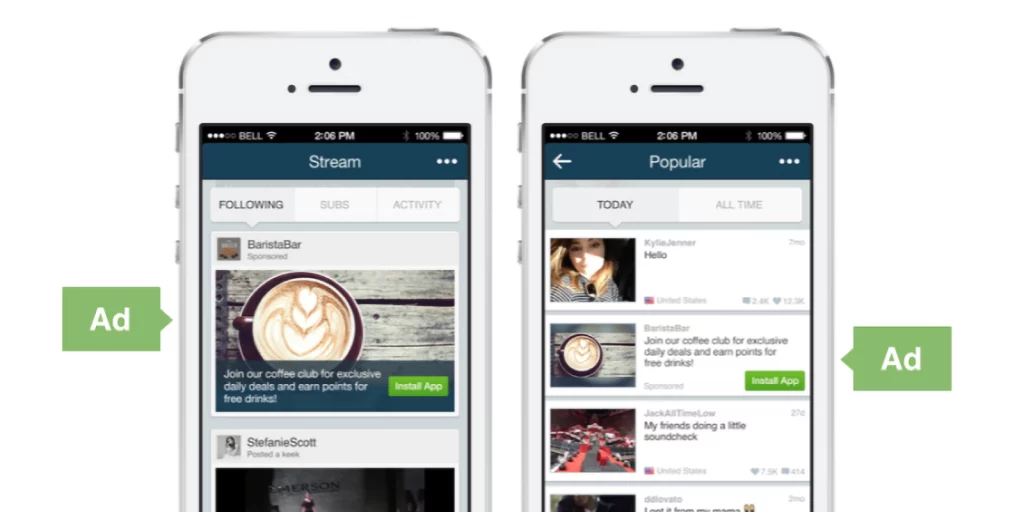
In-app native ads are integrated within mobile applications, providing a seamless and non-disruptive user experience. These ads can take various forms, such as banners, interstitials, or video ads.
- Pros: In-app native ads are highly effective due to their ability to reach users while they are highly engaged with the app. They match the app’s look and feel, enhancing user experience and interaction.
- Cons: Developing and integrating in-app ads can be complex and require significant technical resources. If not properly integrated, they can disrupt the user experience and lead to a negative outcome.
Key Takeaway: In-app native ads are particularly effective for reaching mobile users, making them a powerful tool in native ad arbitrage. However, proper integration is necessary to ensure a seamless user experience.
What to Prepare Before Creating a Native Ad Arbitrage Campaign?
Jumping straight to the technicalities or creatives of an ad campaign is a common rookie mistake. So, before setting off your campaign, there are several things you need to brainstorm and prepare thoroughly.
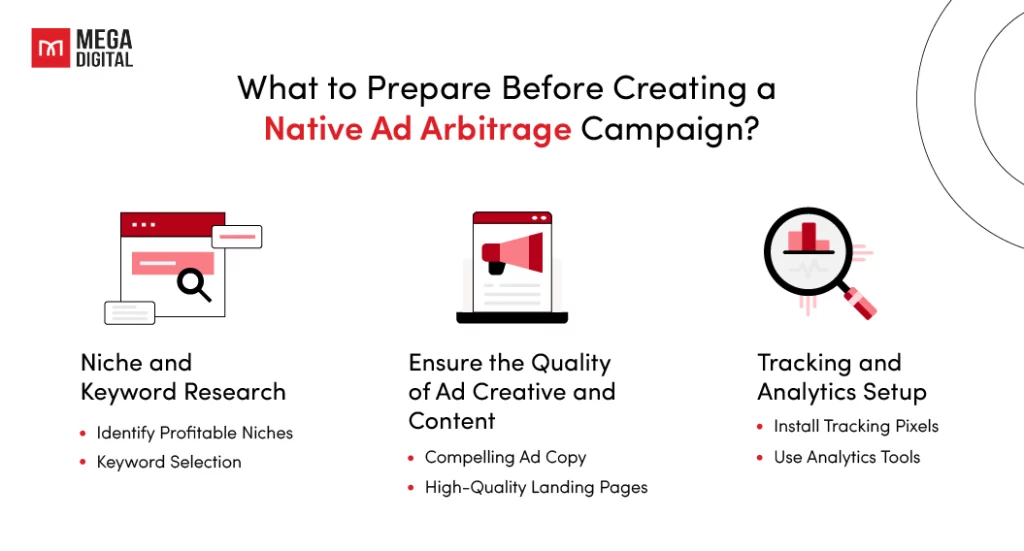
Niche and Keyword Research
Proper niche and keyword research ensure you’re targeting the right audience, which is critical for attracting relevant traffic and maximizing earnings. Without this, you risk spending money on untargeted traffic that doesn’t convert.
- Identify Profitable Niches: Research various niches with tools like Google Trends to find ones with high demand and low competition to maximize profitability.
- Keyword Selection: Use tools like Google Keyword Planner, Ahrefs, or SEMrush to find high-traffic, low-cost keywords that align with your chosen niche. These keywords will drive relevant traffic to your ads and landing pages.
Ensure the Quality of Ad Creative and Content
High-quality ad creatives attract clicks and engage users, while optimized landing pages convert visitors into customers. This directly impacts your native ad arbitrage campaign’s success and profitability.
- Compelling Ad Copy: Write engaging and clear ad copy that attracts clicks. Your ad copy should be concise, relevant, and include a strong call to action. Use A/B testing to determine which versions perform best.
- High-Quality Landing Pages: Ensure your landing pages are well-designed, mobile-friendly, and optimized for conversions. This includes fast loading times, clear and persuasive content, and easy navigation. Tools like Unbounce or Leadpages help in creating effective landing pages.
Tracking and Analytics Setup
Robust tracking allows for data-driven optimization. By understanding which ads perform best and how users interact with your landing pages, you can make informed decisions to improve your campaign’s effectiveness and profitability.
- Install Tracking Pixels: Essential for monitoring ad performance and conversions. Implement tracking pixels from platforms like Facebook, Google Ads, or third-party analytics tools to gather data on user behavior and conversion rates.
- Use Analytics Tools: Utilize tools like Google Analytics, Hotjar, or Mixpanel to track visitor behavior, understand user interactions, and optimize campaigns effectively. These insights will help you refine your strategy and improve ROI.
These preparations are essential for running successful native ads for search arbitrage. Proper niche and keyword research ensure you’re targeting the right audience, compelling ad creatives attract clicks, and robust tracking allows for data-driven optimization.
Best Native Networks for Search Arbitrage
You might be overwhelmed and confused when deciding which native ad network to choose for your native ad arbitrage campaign. Well, I have compiled the most profitable options and summarized a comparison. Let’s have a look!
Taboola
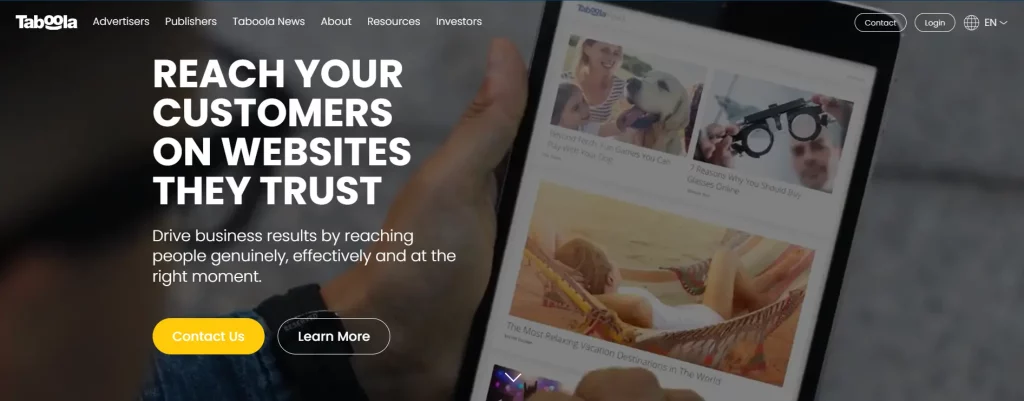
Taboola is a leading content discovery and native advertising platform that connects advertisers with their target audiences through personalized content recommendations. Known for its advanced targeting capabilities and robust analytics, Taboola is a go-to solution for businesses aiming to optimize their native ad arbitrage strategies and maximize ROI.
Outbrain
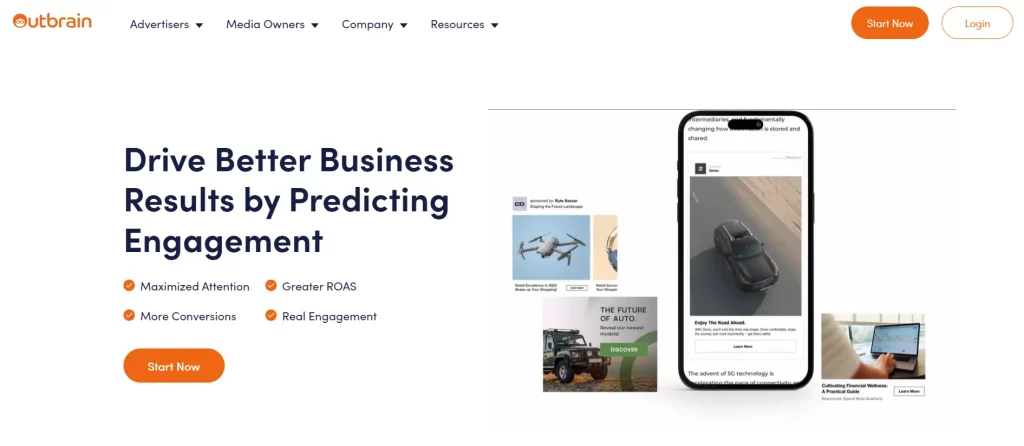
Outbrain’s strong reporting tools and ability to target specific audiences make it ideal for businesses that prioritize a native ad arbitrage campaign with high-quality content and detailed performance tracking. Although it can be more expensive, the high-quality results and ability to fine-tune targeting make it worth the investment for content-focused and premium businesses.
Pangle
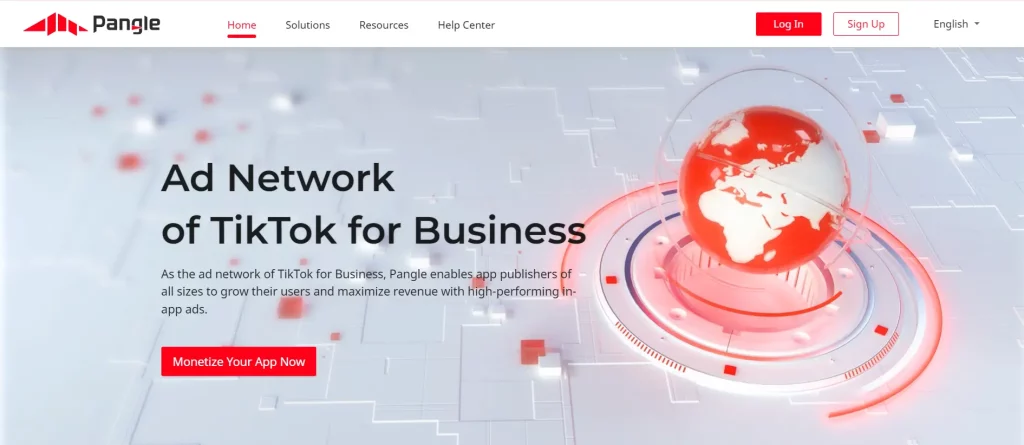
Pangle is a comprehensive ad platform. With a wide range of ad formats and robust targeting options, it is an excellent choice for businesses looking to optimize their ad campaigns. Pangle’s focus on mobile-first advertising and advanced analytics tools ensures high engagement rates and effective campaign performance.
In order to use Pangle, arbitrageurs will need a TikTok ad account. While you can easily create your own standard ad account, it often comes with limitations. A preferred option would be an agency ad account, which offers unlimited targeting options and no spending limits. Mega Digital offers TikTok agency ad account rental services that ensure lower costs while enhancing stability for the most optimal ad campaign.
MGID
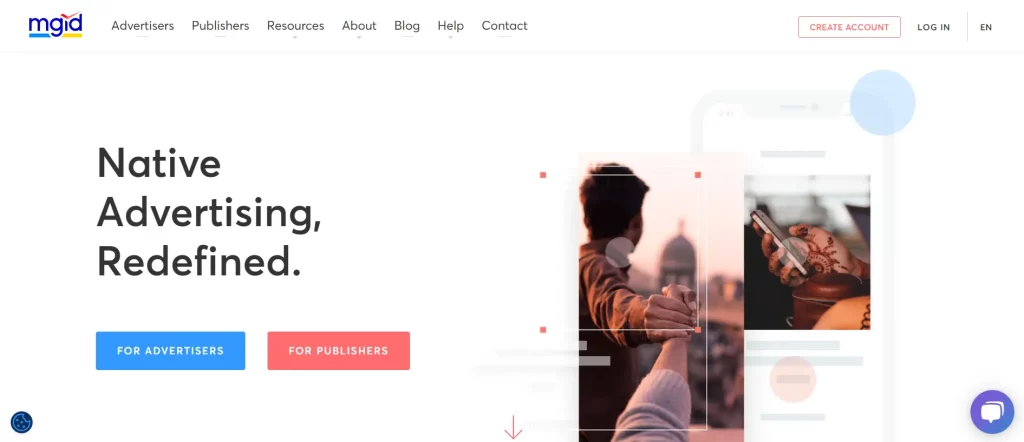
MGID stands out for its flexibility, offering a variety of ad formats and targeting options to suit different advertising needs. One of the key advantages is its accessibility; with a minimum deposit of just $100, it’s a great option for advertisers working with smaller budgets. This makes it easy for anyone to start running effective native ad campaigns without a significant upfront investment.
How to Choose the Perfect Native Ad Network for Your Campaign?
To help you better visualize the detailed differences between these native ad networks, I have summarized a table showcasing their most crucial features.
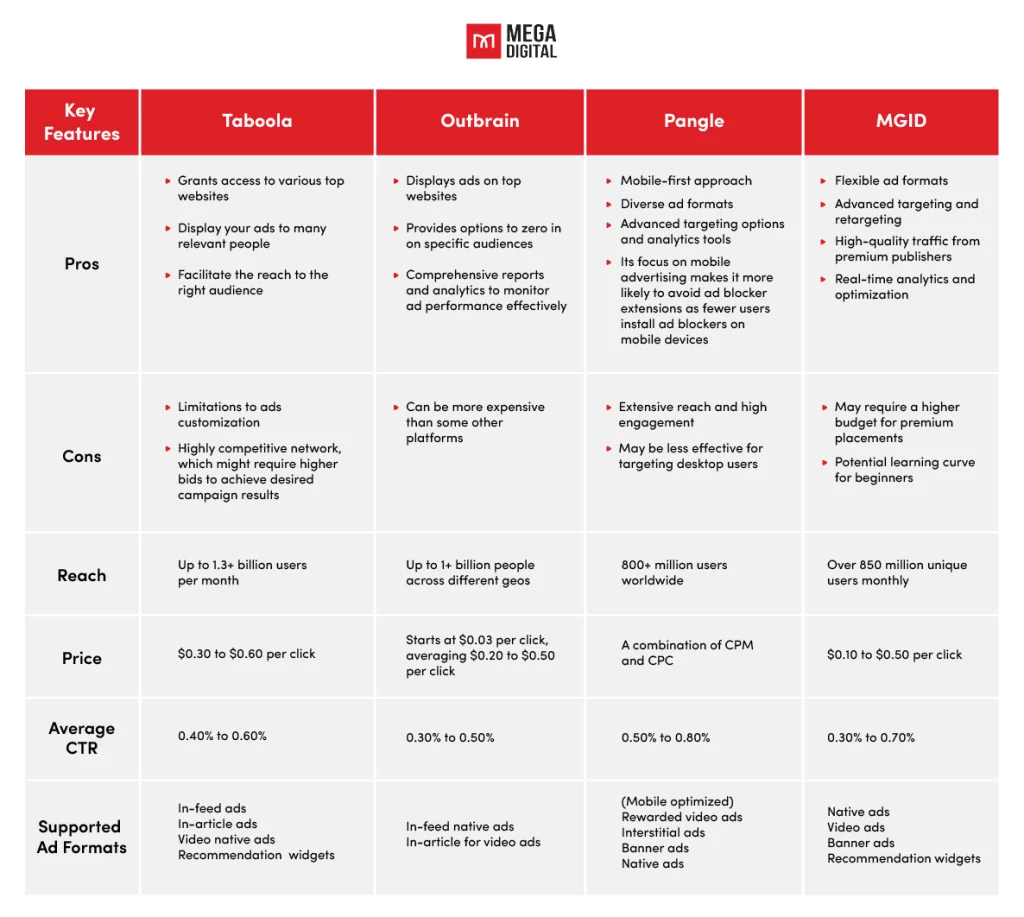
How to Create a Native Ads Campaign for Arbitrage?
After trying all native ad platforms for search arbitrage, I will give you a step-by-step guide on setting up a campaign with Pangle Ads, the ad network of TikTok for Business.
The steps to setting up Pangle ads are similar to those of TikTok Ads, which include 9 main steps.
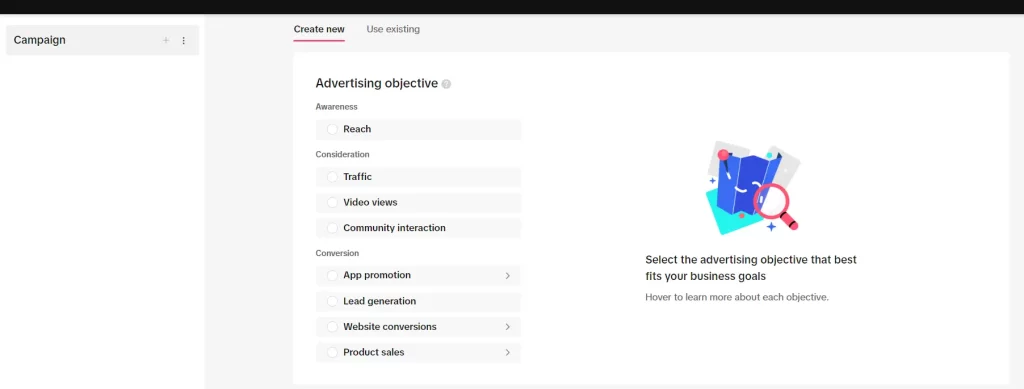
Step 1: Register for a TikTok Ads Account and access TikTok Ads Manager to set up your campaign.
Step 2: Select the goal that best matches the ads for your arbitrage campaign, whether it focuses on awareness, consideration, or conversions.
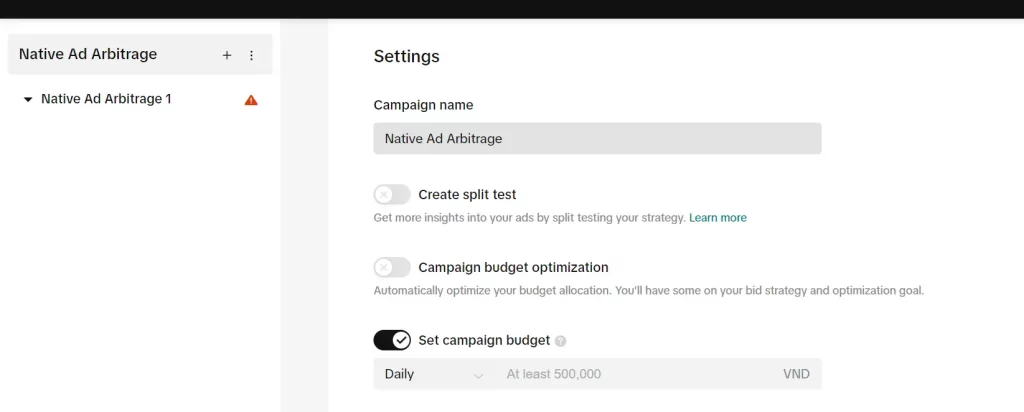
Step 3: Set up Campaign Name and Budget.
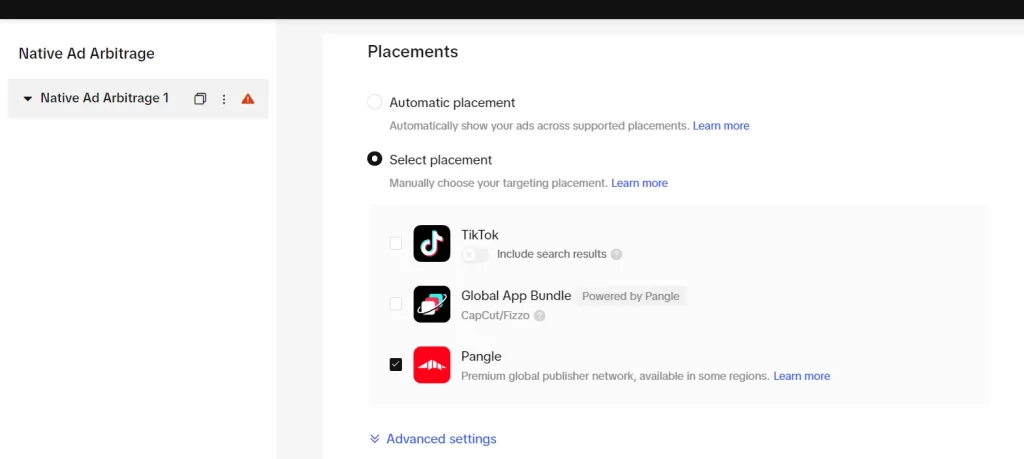
Step 4: Name your TikTok ad group and choose Placements. Under the Placement section, choose Pangle.
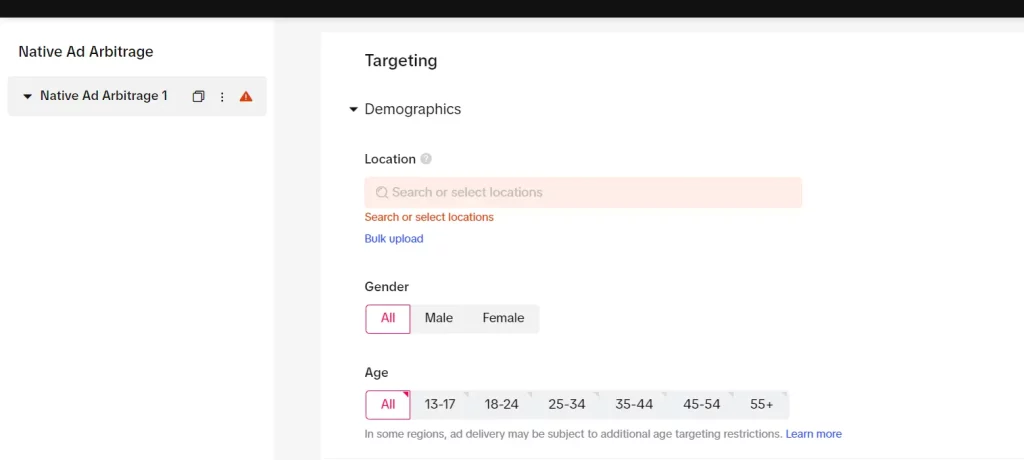
Step 5: Define your target viewers.
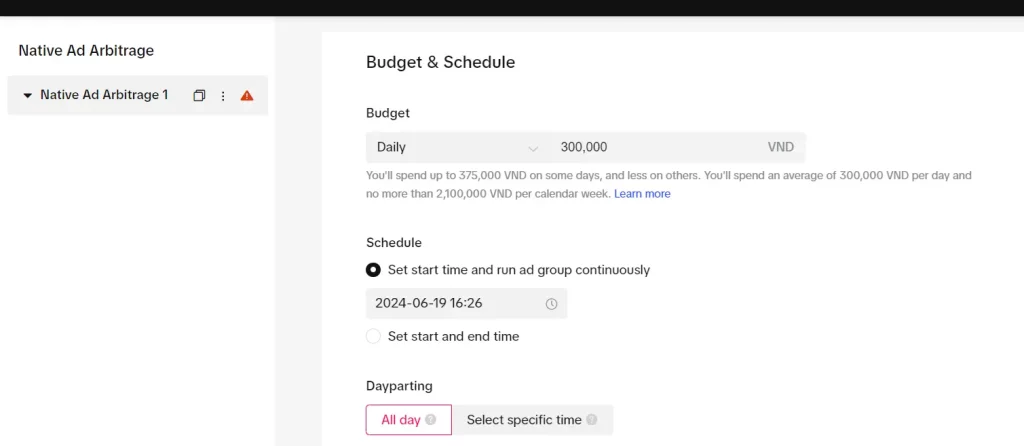
Step 6: Schedule and set up a budget for your ad group.
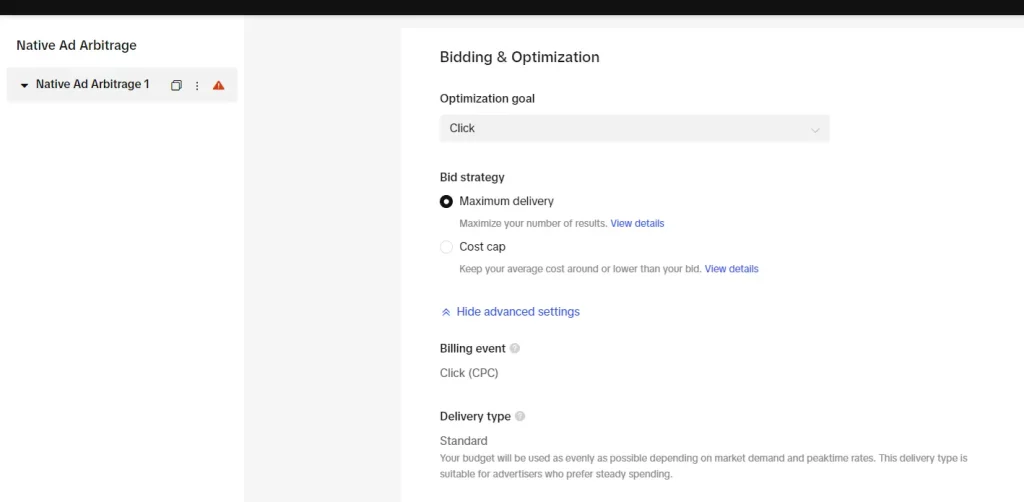
Step 7: Create a bidding strategy and optimize it.
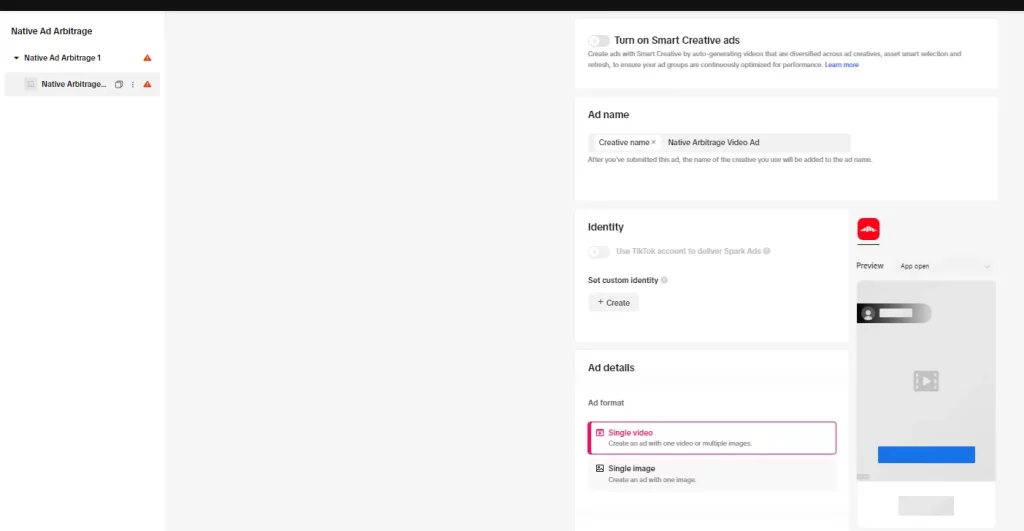
Step 8: Define your ads and finalize your campaign.
Tips to Have a Well-Performing Native Ads Campaign
Detailing and polishing native ads is essential for ensuring they perform well and deliver the desired results. Let’s have a look at some effective tips to help you get the most out of your native ad campaigns for arbitrage:
Write Persuasive Ad Copy

The text in your native ads should be clear, compelling, and concise. It should grab the reader’s attention and encourage them to take action.
- Make Compelling Headlines: Your headline is the first thing users see. According to Copyblogger, 80% of internet users will read your headline, but only 20% will read the rest of the content. So, make it intriguing and relevant to entice clicks.
- Focus on Benefits: Highlight the benefits of the subject showcased in your native arbitrage ads, as users spend 80% of their time (according to Nielsen Norman Group) looking at information above the fold. Show how it solves a problem or adds value to the user’s life.
- Keep It Simple: Avoid jargon and overly complex language. Keep your message straightforward and easy to understand to draw users’ attention.
For example, for a fitness ad, the title “Discover 20 exercises and diet tips in this comprehensive fitness plan” is less attractive than “Get your dream body in just 5 weeks with this simple fitness plan.”
Notice the difference? The first discusses aspects, such as exercises and diet suggestions. Meanwhile, the second emphasizes the benefits, such as accomplishing fitness objectives and molding an ideal body quickly. Plus, the wording is simpler and easier to understand in the second instance.
Craft a Strong Headline or Call to Action (CTA)

A strong headline or CTA is essential for guiding users towards the desired action, which is clicking on your ads.
- Be Clear and Direct: Use clear and direct language for your heading/CTA. Phrases like “Learn More,” “Exclusive,” are effective in creating a sense of uniqueness and tempt interactions from visitors.
- Position Strategically: Place your heading/CTA in a prominent position where it’s easily visible and stands out from the rest of the ad content.
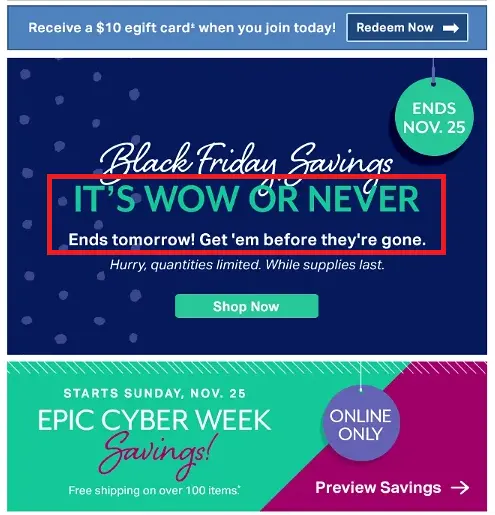
You also have the chance to exploit the psychological factors and “manipulate” the users to draw them to your ads. You can do this by:
- Targeting users’ fear of missing out: For example, “Everybody’s Following This Trend Now,” “Find Out The Secret To … That Influencers/Trendsetters Use,” etc. are phrases that would provoke curiosity.
- Evoking their emotions: As people tend to act on their feelings, give them a story that they cannot overlook, like a heartwarming animal rescue story.
Focus on Mobile Optimization
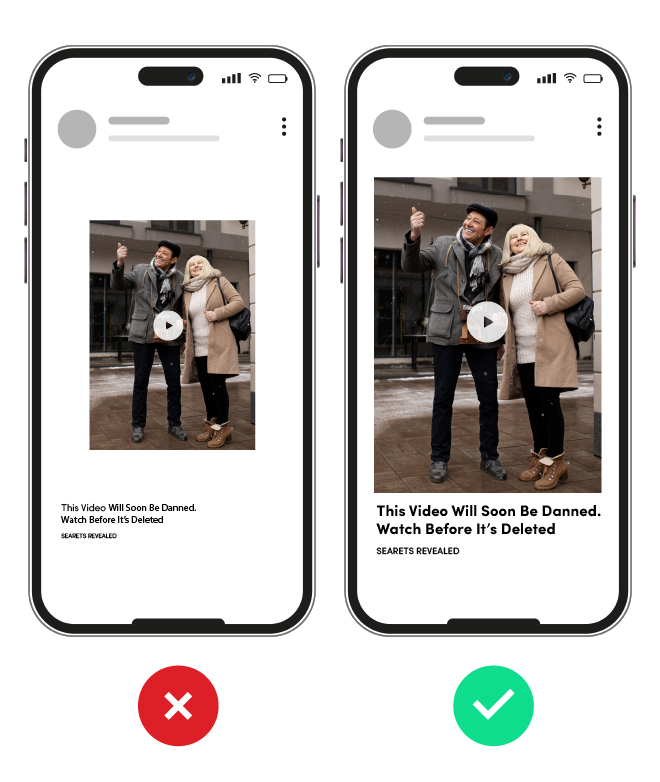
With a significant amount of web traffic coming from mobile devices, ensuring your native ad arbitrage campaign mobile-optimized is crucial.
- Responsive Design: Ensure your ads and landing pages are responsive and look great on all screen sizes. According to Google, 61% of users are unlikely to return to a mobile site they had trouble accessing, and 40% visit a competitor’s site instead.
- Fast Loading Times: Google’s research shows that 53% of mobile users abandon a site if it takes longer than three seconds to load. This emphasizes how loading times can affect traffic acquisition.
An Example of a Native Ad Arbitrage Campaign & Lessons Learned
A digital marketing agency, Mega Digital’s client, tried native to search arbitrage to drive traffic to their tech blog sites.
For privacy reasons, the client’s information shall be kept anonymous.
Challenges Faced
- High CPC: The cost per click was higher than expected, reducing profit margins.
- Bot Traffic: Significant non-human traffic lowered engagement and conversion rates.
- Low Conversion Rates: High traffic did not translate into expected conversions, affecting ROI.
- Ad Placement Issues: Suboptimal ad placements led to poor visibility and click-through rates (CTR).
- Content Mismatch: Ads were not well-aligned with landing page content, resulting in high bounce rates.
Strategies Implemented
Traffic Source Optimization:
- Selected Native Ad Platforms: Used Outbrain and Taboola to place ads on high-traffic websites, ensuring seamless integration with content.
- Traffic Quality Filters: Implemented tools like ClickCease to filter out bot traffic, ensuring higher-quality human traffic.
Ad Content and Placement:
- A/B Testing: Tested different ad creatives and headlines to find the most effective combinations.
- Optimal Ad Placement: Positioned ads within the content flow for better visibility and increased CTR.
Landing Page Optimization:
- Boost Load Time and Mobile-Friendliness: Optimized landing pages for speed and mobile responsiveness.
- Engaging Content: Created high-quality, relevant content to keep readers engaged and reduce bounce rates.
Monitoring and Analytics:
- Real-Time Analytics: Used Google Analytics and Hotjar to track user behavior and engagement.
- Continuous Optimization: Regularly analyzed performance metrics and adjusted strategies.
Results
- Reduced CPC: Lowered CPC by 25%, from $0.80 to $0.60.
- Increased Conversion Rates: Enhanced landing pages and better ad alignment increased conversion rates from 2% to 17%.
- Higher ROI: Improved ROI from 50% to 75%.
- Reduced Bot Traffic: Reduced bot traffic by 30%, ensuring more engaged human traffic.
Final Take
To succeed in a native ad arbitrage campaign, thorough preparation, including research, audience targeting, and content testing, is crucial, along with continuous optimization.
Hopefully, this guide, with detailed information on the best native ad networks and how to optimize native ads for arbitrage, will help you build a strategy to maximize your profit and ensure a successful campaign.
If you are seeking support on advertising in general or native ads for arbitrage, contact Mega Digital today for a free expert consultation!
>>> Read more: What is Search Feed Arbitrage? How to Monetize It in 2025?







